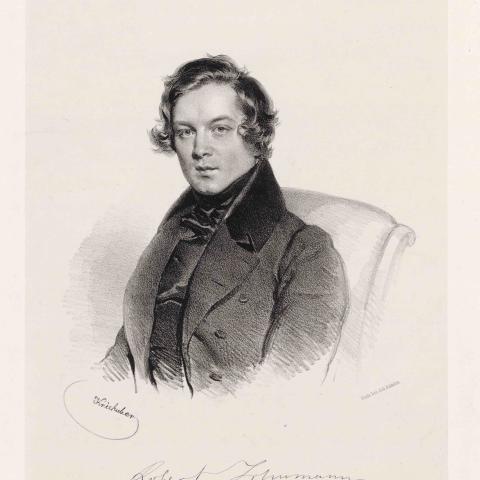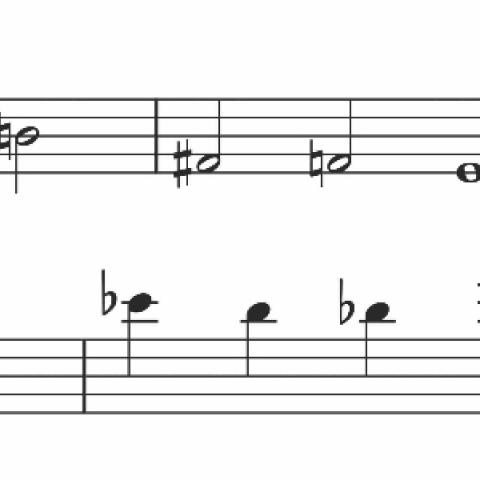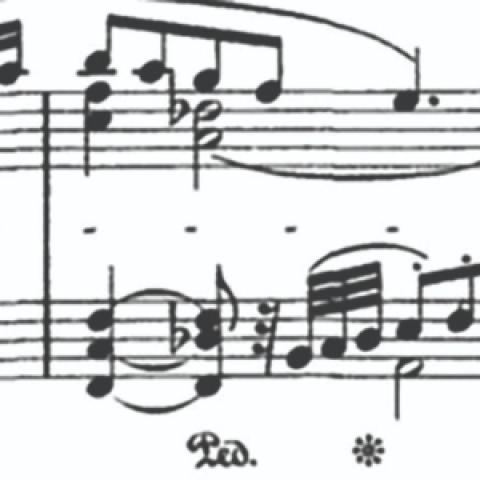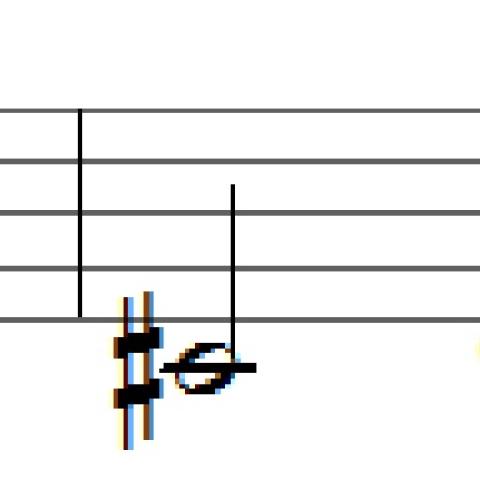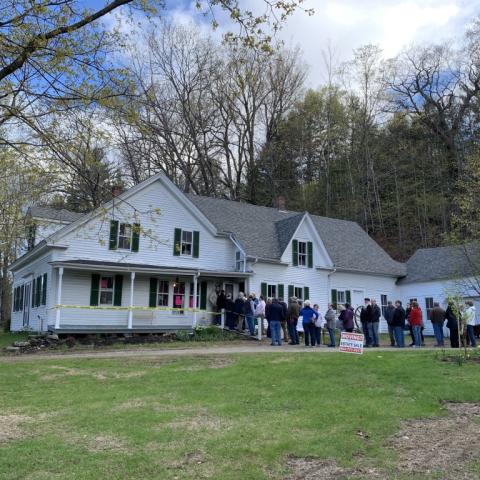Sarah Mahler Kraaz is William Harley Barber Distinguished Professor and professor of music and organist of the college at Ripon College, Ripon, Wisconsin, where she teaches piano, organ, and harpsichord, music history courses, “Women in Music,” “Music and Art,” and “Music and War.” Her edited volume, Music and War in the United States, has been recently released by Routledge.
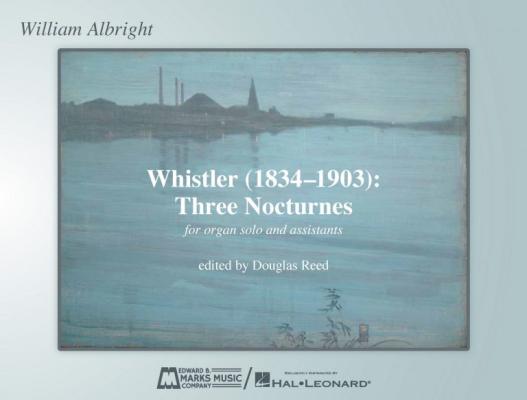
William Albright, Whistler (1834–1903): Three Nocturnes for organ solo and assistants, edited by Douglas Reed. Edward B. Marks Music Company, www.ebmarks.com, www.halleonard.com.
In the late 1980s William Albright was commissioned by the Harvard Art Museums to write a work for organ, with the suggestion that he find inspiration among the collections there. He was drawn to some of the paintings by James McNeill Whistler in the Fogg Museum, in part because he could see musicality in their subject matter and execution, but also because Whistler titled the series “Harmonies,” “Symphonies,” and “Nocturnes.” Albright chose two of the latter—Nocturne in Grey and Gold and Nocturne in Blue and Silver—plus one from the Detroit Institute of Art, Nocturne in Black and Gold: The Falling Rocket, as the subjects for a three-movement work.
Sadly, however, Albright did not finish the piece before his death in 1998; he left sketches, an annotated performance manuscript, and a recording of his performance at the University of Wisconsin-Madison in 1989 to the University of Michigan Bentley Historic Library where Douglas Reed discovered them. Hence, this new publication is the result of two years of painstaking editing by Reed and Evan Hause of Marks Music to reconstruct Albright’s work using these sources from the composer.
The preface includes all of the comments from Albright’s performance score as well as his thoughts from the sketches—which reveal a fascinating engagement with Whistler’s art—organized by Reed with his own performance notes on Albright’s notational language and improvisational passages. Reed describes his editing process, making clear what are his words and what are the composer’s.
To begin to understand and appreciate the Nocturnes, one must study the visual art that was the inspiration for the music. A twofold process—researching Whistler’s esthetics, including why he chose musical titles for his pieces, and looking long and carefully at images of the three paintings—was the starting point for this review. Whistler was an American ex-pat who spent most of his life in Europe, specifically London, although he also lived in Venice for a time. He modeled his art from the 1870s upon musical principles, using the idea of line, harmony, and color rather than subjects with emotional associations to organize his works. A much-quoted passage in his autobiography, The Gentle Art of Making Enemies, explains:
As music is the poetry of sound, so is painting the poetry of sight. . . . Art should be independent of all claptrap, should stand alone, and appeal to the artistic sense of eye or ear, without confounding this with emotions entirely foreign to it, as devotion, pity, love, patriotism, and the like. All these have no kind of concern with it; and that is why I insist on calling my works ‘arrangements’ and ‘harmonies.’1
Whistler originally titled his paintings “moonlights” but changed them to “nocturnes” at the suggestion of a patron who was familiar with the piano works of Chopin. The idea of night, with its associations of loneliness, mystery, brooding introspection, melancholy, and less often, hope and warmth, appealed to Romantic sensibilities—and to Albright (See “Nocturne” in Organbook III). The titles of Whistler’s paintings describe the dominant colors (analogous to key relationships in tonal music) of each, and his technique of combining colors in different places produces visual harmony. In his “Ten O’Clock” lecture given a decade after these paintings were made, Whistler reiterated the connection between painting and music:
Nature contains the elements, in colour and form, of all pictures, as the keyboard contains the notes of all music. But the artist is born to pick, and choose . . . these elements, that the results may be beautiful—as the musician gathers his notes, and forms his chords, until he brings forth from chaos glorious harmony.2
I. “Nocturne in Grey and Gold: Chelsea Snow” is a winter scene with four elements that Albright identifies musically: a broad snowy road, tinged with bluish-gray and gold, that mirrors the sky (translated as a widely spaced texture with low Krummhorn sounds in the left hand and high register flute tones in the right hand); fused, or blurred, forms of snow, trees, and buildings (quiet low-register tremolandi); floating notes of light that punctuate the darkness of buildings (ad-libbed single notes on light, bright stops in the Positiv against the soft, 16′, 8′, and 4′ left-hand accompaniment); and a single, anonymous figure walking towards the nearest well-lit building—a tavern? home? (a gently undulating, rhythmically irregular line at the close). Whistler warms his painting by the subtle, pervasive use of gold, and Albright does the same for the music by suggesting soft flue stops.
II. “Nocturne in Black and Gold: Falling Rocket” is a dramatic depiction of fireworks in Cremorne Gardens (a popular park in London) and is one of Whistler’s boldest and most (in)famous works. It is intensely vertical—the focal point is an explosion of rockets and the shower of falling sparks from high in the black nighttime sky. Whistler’s attempt to portray the exciting sensation of fireworks in an abstract manner provoked the critic John Ruskin to declare that “a pot of paint is flung in the public’s face.” (Whistler subsequently sued Ruskin for slander and won the suit but only received a farthing in damages.)
Albright wrote that “The Falling Rocket . . . is an ‘impression’ of the painting, with its battle-like energy, its explosion of color, its violent thrust upwards and vivid fallout interpreted in music.” In an opening gesture reminiscent of his teacher, Messiaen, Albright’s music literally explodes onto the page with upward-leaping clusters of sixteenth notes that settle into sustained chords. Another statement follows, in which ostinato pitches are added in a textural crescendo. Albright considered subtitling this piece “toccata.” In measure 24 the performer is instructed to play thick chord clusters of white notes (right hand) and black notes (left hand) in a cascade of “sparks.” Meanwhile, as bursting rockets and falling bits of burning ash occupy the performer’s hands, the feet are busy with a prominent twenty-three-note sequence in the pedal that repeats six times in the course of the movement. The effect is that of a French toccata, but the structural technique is more complex. It is rather like the color—a repeating melodic pattern—in medieval isorhythm. The frequent meter changes and ensuing rhythmic shifts render the melodic line difficult to detect, so although the listener hears the bass line quite clearly, the repetition is not obvious. This foundation anchors the movement even as more and more improvisation (“wild white notes”) is required on the manuals.
III. “Nocturne in Blue and Silver” (reproduced on the cover of the score) is a tonally cool work—blue and silver wash over a reddish-white ground—mysterious, atmospheric, and timeless in its evocation of dusk on the Thames River. Whistler painted the water with even brushstrokes that cover the canvas from one side to the other, and the factory/warehouse and smokestacks across the water from the viewer lie low on the horizon. Albright notes, “The idea of beautiful design found in an unpromisingly shabby, industrial shoreline must have excited Whistler,” who rhapsodizes:
And when the evening mist clothes the riverside with poetry, as with a veil, the poor buildings lose themselves in the dim sky, and the tall chimneys become campanili, and the warehouses are palaces in the night, and the whole city hangs in the heavens, and fairy-land is before us—then the wayfarer hastens home . . .3
The key words here are “poetry,” “campanili,” and “palaces;” the key concept is transformation. Albright studied Whistler’s technique carefully before arriving at the idea, analogous to the wash over a ground, of using wedges of notes on one keyboard and pedal that show through the ever-changing wedge-shaped figures (outer, fixed notes and all the notes in between that are gradually released) on the other manuals. The music flows ceaselessly, like the Thames, even when notes singly and in pairs break the surface like little ripples. Sinuous lines of continuous chromatic improvisation against over-legato chromatic descending lines (measure 24) or stationary pitches recreate the horizontal orientation of the painting. A gradual increase of surface activity and a thickening of texture smooth the way for the appearance of the “campanili e palazzi” in measure 48. Albright explains:
As a coda—conceivably for the entire set—I have added music inspired by Whistler’s powerful image of the smokestacks becoming campanili and the warehouses becoming palaces. In composing these bell-towers and castles of sound I hope to give tribute to the painter and his paradox, a duality of intent that wanted abstraction and representation at the same time, the generous “both/and” that is the exciting imperative of artistic achievement.
The bell towers and castles are massive vertical structures built from chord clusters in the pedal up through the extreme treble on the manuals, but mass does not equal volume in sound (the loudest dynamic marking is forte). Bursts of thirty-second notes punctuate the sound mass and thick downward-arpeggiated chords suggest bells. At the very end of the movement two handbells ring simultaneously; they are the last sounds heard.
Whistler (1834–1903): Three Nocturnes is a unique, complex work that demands much of the performer and audience; eyes, ears, intellect, and imagination are essential. The music makes technical demands on the organist—palm glissandi, tremolandi, chord clusters, coordination with an assistant, and improvisation—that are challenging but not impossible. Although Albright did not mention projecting Whistler’s images during a performance, doing so seems almost essential given the close connection between the paintings and the music. A pre-concert talk by an art historian might also be appropriate.
One artist painted on the organ, the other on canvas. Both created works of great dramatic contrast. Albright’s adventurous exploration of color, form, and technique match Whistler’s in intensity and effect. These pieces are a valuable and welcome addition to twenty-first-century organ repertoire—they sound fresh and contemporary even thirty years after they were written. Messrs. Reed and Hause at E. B. Marks Music are to be commended for their painstaking work in making Albright’s opus ultimus available to the public.
Notes
1. James McNeil Whistler, “The Red Rag,” in Denys Sutton, James McNeill Whistler; Paintings, Etchings, Pastels & Watercolours (London: Phaidon Press, 1966), 58.
2. Ibid, p. 51.
3. Frances Spalding, Whistler (Oxford: Phaidon, 1979), p. 50.


